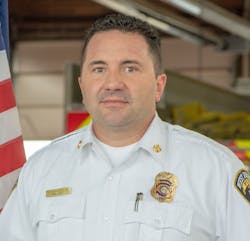Health & Wellness: Making Mental Health Mandatory
The U.S. fire service ostensibly isn’t doing enough to break down barriers and facilitate access to mental health services for first responders. Recent research by Ruderman Family Foundation indicates that firefighters are more likely to die by suicide than they are in the line of duty. We recognize the dangers that are inherent in the physical work that members carry out; hence, we mandate annual physicals and physical agility tests as job requirements. We also stress the importance of regular exercise and a healthful diet. However, if suicide and mental health issues are a bigger threat, why haven’t we taken similar bold steps to mitigate the problem? Why do we continually address mental health with a degree of passivity and “optional” fixes, particularly when we know that both pragmatic and stigma-based barriers make it difficult for first responders to seek the help that they need? The fire service actively must start breaking down barriers and making privacy-sensitive mental health assessments mandatory for firefighters everywhere.
The West Jordan City, UT, Fire Department (WJFD) is addressing the issue via a proactive approach. Hopefully, other departments can learn from and even build upon the steps that the WJFD took/is taking to address this very serious matter.
Program development
In 2019, following a discussion in a command staff meeting, a committee was assigned to consider ways to facilitate access to mental health services for the department’s firefighters, including the possibility of making it mandatory. Potential hurdles to overcome, such as cost, stigma, and legal and privacy concerns, were recognized, but the command staff believed that it was worth the time and effort to move forward. Saving or helping even one firefighter was enough justification for any additional work that would be required or potential challenges that would be involved.
The first objective was to establish a relationship with a mental health professional. Contracting or having a professional counselor on retainer was considered, but the cost proved to be somewhat prohibitive. The department also considered using the free Employee Assistance Program (EAP), which was set up as a benefit through city leaders. Unfortunately, feedback with respect to the EAP indicated that most of the counselors, while well-meaning and professional, were ill-equipped to handle the trauma that first responders face.
However, further research revealed one EAP counselor who gained a reputation as someone who understood the unique trauma and issues that firefighters encounter. Previously, she met with some firefighters and received good reviews. She also provided mental health training to other fire departments that are in the area.
After an explanation of what the WJFD was trying to do, the counselor worked through her director to ensure that she could work with the department in that capacity. Her early-stage contributions in regard to how the program might be executed proved to be extremely helpful.
Like an annual physical
The legality of mandating mental health visits and how to maintain privacy needed to be addressed next. By working with the city attorney, a plan to address these issues without violating rights was conceived.
Employees would be mandated to visit with the contracted mental health professional once per year (in the same vein as an annual physical). The content of that meeting wasn’t important to the WJFD and wasn’t tied to any kind of fitness-for-duty evaluation or determination. The desire, simply, was for firefighters to meet with the counselor. The department believed that mandating a visit at least would remove the barrier of people having to admit that they need help and/or make an appointment and follow through. They could walk in and say that they were fine and be done, or they could stay and discuss anything that might be a concern to them. The department wouldn’t know either way and didn’t care.
The department anticipated that most people initially would go to their required appointment and claim that they didn’t need anything but then might say something along the lines of, “Well, while I’m here, I do have a question … ” which would open the door to more discussion.
Mandating the visit for all firefighters also removed any stigma that’s associated with seeing a counselor, because it was required by the department. Moreover, because everyone was doing it, there would be no assumption or singling out of anyone who might be struggling with an issue.
If after talking with the counselor it was decided that there should be further sessions or treatment, that would be entirely between the firefighter and counselor and no longer involve the department. All that the department would know was that the firefighter went to the yearly appointment.
Rollout
Once all of the details were worked out and approved, the department set a date for the counselor to be at the headquarters station. Having her come to the department was extremely helpful, because it allowed the WJFD to operate out of a centralized location, which negated the need to schedule 90–100 separate appointments.
The counselor blocked out a few hours, with the expectation that she wasn’t going to do any counseling per se but just would provide a little bit of training and meet with each firefighter for a few minutes to help to determine whether an individual needed to make an appointment for future sessions.
The battalion chief (shift commander) brought each crew to the headquarters station and introduced the program to the crew, with the explanation of what was being done and why. The fact that this had no bearing on job status and was nothing more than the department just trying to help, to communicate that members were valued and their well-being was of concern, was emphasized to the crew members.
The counselor then briefly introduced herself and shared a few thoughts before handing out a short questionnaire for the firefighters to fill out (see “An Introductory Mental Health Questionnaire”). She then went into a private room, and, one-by-one, each firefighter went in and talked with her. While individual firefighters rotated in and out with the counselor, the training division of the WJFD taught a brief class on well-being for the rest of the group.
Reception
The department was somewhat concerned that there might be pushback during the time that the program was implemented, particularly because of the tendency among firefighters for them to act as if there never is anything wrong/any personal problems. The department was pleasantly surprised by the reception among the firefighters: Almost all of the feedback was positive. Surprisingly, some employees requested to meet more than just once per year.
The follow-up with the counselor supported the feedback from the firefighters. She obviously didn’t share anything of a personal nature or anything identifiable but reported that some firefighters made comments like, “I probably should have reached out to someone sooner with this … ” and “It would probably be good for me to talk to someone.” She also reported that she scheduled future appointments with some firefighters. Whether those appointments are for PTSD, marital problems, financial issues or substance abuse, the department doesn’t know nor does it matter. If even one person can be saved from suicide, divorce, bankruptcy or some other self-destructive behavior, the program will be considered a success. Such a thing might never be known, but that’s acceptable to the WJFD.
Face it head on
Going forward, the program will continue to be evaluated and adjusted as necessary. One idea that’s likely to be implemented is to require an initial visit for all new employees as part of the hiring/onboarding process. Again, this isn’t for use as a selection tool in any way but, rather, to provide new employees with an established lifeline for their career. They will have created a relationship (albeit brief) with a counselor prior to experiencing any of the stress or trauma that they will no doubt encounter. During that initial visit, the counselor can provide some preemptive counseling and helpful coping tools right from the start.
Fireground deaths and injuries are decreasing in large part because of mandatory safety initiatives and focus efforts of proactive leadership in the fire service, in general, and at departments, specifically. However, the service faces a less obvious threat to safety and must take a similarly aggressive approach to mitigate the deadly effects of mental illness. The WJFD program admittedly is a work in progress. There will be difficulties ahead. However, the department’s leaders owe it to their firefighters to face this challenge head on.
An Introductory Mental Health Questionnaire
The West Jordan City, UT, Fire Department mandated an annual mental health visit with a counselor for its firefighters. Saving or helping even one firefighter who is struggling with PTSD, marital problems, financial issues or substance abuse was the goal. When the program was introduced to the whole department, members were asked to complete the following questionnaire.
Please answer the following questions as best you can, identifying changes from your norm. For each question, choose one of the following answers: N=Never / S=Sometimes / O=Often
1. Do you have difficulty sleeping (more than affected by shifts)? N S O
2. Have you noticed an increase in irritability or quickness to anger? N S O
3. Do you have trouble concentrating? N S O
4. Are you not feeling like yourself (loss of energy or motivation)? N S O
5. Have you had intrusive memories/repeating of a memory? N S O
6. Are you withdrawing from family or loved ones? N S O
7. Have you been struggling with substance abuse? N S O
8. Do you believe that life is pointless or hopeless? N S O
9. Are you separated, divorcing or going through a breakup? Yes No
10. Have you had a life change in the past six months: health/work/money/family/home? Yes No
About the Author

Derek Maxfield
Derek J. Maxfield is a third-generation chief officer who was appointed West Jordan, UT, Fire Department’s fire chief in 2019. He began his career as a paid-call firefighter with the Salt Lake County, UT, Fire Department in 1998 and was hired full-time with the Sandy City, UT, Fire Department in 2001, where he spent 18 years serving as paramedic, engineer, captain, battalion chief and deputy fire chief. Maxfield is an adjunct faculty member in the Utah Valley University Emergency Services Degree program. He was awarded Chief Fire Officer designation (CFO) and holds an associate degree in fire science, a bachelor's degree in communication from the University of Utah and a Master of Public Administration from the Marriott School of Management at Brigham Young University.
